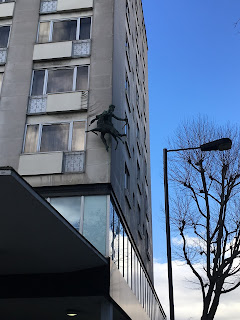A few weeks ago, I went for a guided walk around Chingford, nothing unusual there – I have lived there for over 50 years – but what was unusual was to discover some places and paths I knew nothing about.
Joanna Moncrieff, a Westminster and also Clerkenwell and Islington Guide might be a bit out of her turf here, but Chingford really IS her turf as like myself she has lived here for a great number of years. Chingford is in Waltham Forest, a London Borough and not in Essex as some people still believe although it does at times feel like you are in the country.
We meet at Chingford Station wearing several layers of clothing, this was mid-October and none of us really believed the forecast – sunshine and 20 degree temperatures!
After hearing about the history of Chingford from its beginnings as a hamlet we crossed the road, getting our first glimpse of Epping Forest in all its glory and taking a longer look at Chingford Station. This is now an Overground station but was built in the 1870s. Joanna told us the part it played in the history of Epping Forest and its Royal connections (no spoilers here). She also showed us a tithe map from 1838 which detailed all the fields, paths, and roads that made up Chingford. This would become significant later in the walk and was referred to often.
We then left the main shopping street, Station Road and headed into the suburb proper looking at the different types of speculative building that happened after the railway came to town. Large villas with lots of whimsical detail were the norm, sadly most of these are now converted into flats.
Back on Station Road, we looked at the impressive church and one or two of the local pubs, hearing tales of famous people who have made Chingford their home. I do mean famous, not infamous although we have had a few of those as well.
As an added extra to the walk on the Saturday I went along we were able to spend some time at Pimp Hall Dovecote where there was an Apple Day celebration. The recently refurbished 17th-century dovecote is beautiful and with the blue sky and warmth, we spent time looking at the stalls and eating a cream tea. By now most of us were down to t-shirts and sat down for a few minutes to enjoy the setting and the warm sunshine.
We left the Apple Day celebrations and made our way across a woodland path and over some open space to see one of the ancient Manors of Chingford.
Up until this point, I knew all the places that Jo spoke of but not always their history and relevance, but now we took uncharted territory for me, in Chingford, somewhere I know like the back of my hand. The tithe map reappeared, and Jo showed us a network of paths which we were able to follow through the modern day streets. These took us past an important sporting space I was unaware of and also led us back into the forest.
The walk finished in Epping Forest at one of Chingford’s most famous buildings, The Queen Elizabeth Hunting Lodge. It is an impressive building but unfortunately on the day that we visited it was covered in scaffolding. The walk was over and all that was left was a 10-minute walk back to the station.
This is a lovely walk and is well worth booking and it has its next outing on the 17th November, tickets can be booked here.
Leigh Stanford
East London of Foot guide
















































